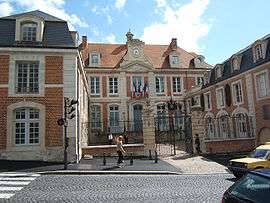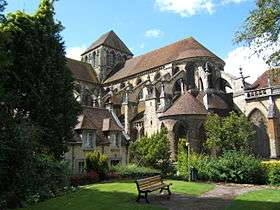Lisieux
| Lisieux | ||
|---|---|---|
|
Town hall | ||
| ||
 Lisieux | ||
|
Location within Normandy region 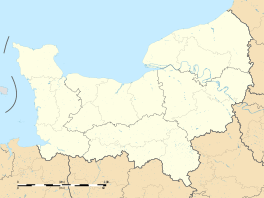 Lisieux | ||
| Coordinates: 49°09′N 0°14′E / 49.15°N 0.23°ECoordinates: 49°09′N 0°14′E / 49.15°N 0.23°E | ||
| Country | France | |
| Region | Normandy | |
| Department | Calvados | |
| Arrondissement | Lisieux | |
| Canton | Lisieux-1, Lisieux-2, and Lisieux-3 | |
| Intercommunality | Lisieux Pays d'Auge | |
| Government | ||
| • Mayor (2008–2014) | Bernard Aubril | |
| Area1 | 13.07 km2 (5.05 sq mi) | |
| Population (2006)2 | 22,109 | |
| • Density | 1,700/km2 (4,400/sq mi) | |
| Time zone | CET (UTC+1) | |
| • Summer (DST) | CEST (UTC+2) | |
| INSEE/Postal code | 14366 / 14100 | |
| Elevation | 32–152 m (105–499 ft) | |
|
1 French Land Register data, which excludes lakes, ponds, glaciers > 1 km² (0.386 sq mi or 247 acres) and river estuaries. 2 Population without double counting: residents of multiple communes (e.g., students and military personnel) only counted once. | ||
Lisieux (French pronunciation: [li.zjø]) is a commune in the Calvados department in the Normandy region in northwestern France. It is the capital of the Pays d'Auge area, which is characterised by valleys and hedged farmland.
Name
The name of the town derives from the Latin Noviomagus Lexoviorum ("Noviomagus of the Lexovii"). The town was originally known in Celtic as Novio Magos ("New Field", "New Market"), which was Latinized as Noviomagus. Owing to the large number of similarly-named cities, however, it was necessary to specify where this one was located. The local French demonym "Lexoviens" derives from the Latin as well.
History
Antiquity
Lisieux was the capital of the Lexovii. In his work, Commentaries on the Gallic War, Caesar mentions a Gallic oppidum, a term which refers to Celtic towns located on the tops of hills. The oppidum has been pinpointed to a place referred to as le Castellier,[1] located 3 kilometers (1.9 mi) to the southwest of the town. However the Gallo-Roman city was in fact located where Lisieux is to be found today.
Middle Ages
Lisieux was an important center of power in medieval times. The bishopric of Lisieux controlled most of the Pays d'Auge by the 12th century. King Henry II and Eleanor of Aquitaine are thought to have married at Lisieux in 1152, and the town remained powerful for several centuries afterwards until in the 14th century the triple scourges of the Plague, war and resulting famine devastated Lisieux and reduced its influence. The main judge of Joan of Arc, Pierre Cauchon, became a bishop of Lisieux after her death and is buried in the Lady Chapel of the cathedral.
Events

- 4th century: Presence of the Germanic laeti, auxiliaries of the Roman Army, who settled in Lisieux with their families. Their graves have been discovered in the “Michelet” necropolis, some of which contain artefacts typical of northern Germania.
- 1432: Pierre Cauchon, the supreme judge during the trial of Joan of Arc at Rouen became the bishop of Lisieux. He commissioned the building of the side chapel of the cathedral, in which he is now buried.
- 1590: During the Eighth War of Religion, Henri IV had to fight to win back his kingdom. When he arrived at Lisieux he took the town without force, after the garrison had fled the town.
- 1897: Sister Therese of the Child Jesus of the Holy Face, died in the Carmelite monastery at Lisieux. In 1925, she would be canonized as "St. Therese of Lisieux."
- 1907: The first helicopter flight, piloted by Paul Cornu.
- 1937: Monseigneur Eugenio Pacelli, papal legate and future Pope Pius XII, visited Lisieux.
- 6/7 June 1944: An Allied bombardment killed 800 victims and destroyed two thirds of the town.
- 23 August 1944: Liberation by the Allied troops.
- 1960: Lisieux merged with the Saint-Jacques commune.
- 2 June 1980: Pope Jean-Paul II visited Lisieux.
Geography
Lisieux is situated on the confluence of the river Touques and many of its tributaries: the rivers Orbiquet, Cirieux and Graindain.
The town is in the heart of the Pays d'Auge, of which it is the capital. Lisieux is therefore surrounded by Normandy's typical hedged farmland, where there is a mix of livestock farming (mostly milk cows) and cider apple cultivation (from which cider and calvados are made, not forgetting pommeau).
Climate
Lisieux has a temperate oceanic humid climate.
| Town | Sunshine | Rain | Snow | Storms | Fog |
|---|---|---|---|---|---|
| Paris | 1,797 h/year | 642mm/year | 15 d/year | 19 d/year | 13 d/year |
| Nice | 2,694 h/year | 767mm/year | 1 d/year | 31 d/year | 1 d/year |
| Strasbourg | 1,637 h/year | 610mm/year | 30 d/year | 29 d/year | 65 d/year |
| Lisieux[2] | 1,764 h/year | 711mm/year | 14 d/year | 17 d/year | 54 d/year |
| National average | 1,973 h/year | 770mm/year | 14 d/year | 22 d/year | 40 d/year |
The table below shows the temperatures and precipitation for the year 2007 (provided by the Caen-Carpiquet weather station:[3]
| Month | J | F | M | A | M | J | J | A | S | O | N | D |
|---|---|---|---|---|---|---|---|---|---|---|---|---|
| Average max. temperature (°C) | 10.1 | 11.1 | 11.8 | 17 | 17.3 | 20.1 | 21.3 | 21 | 19.3 | 15.3 | 11.5 | 7.9 |
| Average min. temperature (°C) | 4.7 | 5.5 | 3.5 | 6.3 | 9.4 | 11.5 | 12.9 | 12.6 | 10.3 | 7.3 | 5.2 | 1.9 |
| Average temperature (°C) | 7.4 | 8.3 | 7.6 | 11.6 | 13.3 | 15.8 | 17.1 | 16.8 | 14.8 | 11.3 | 8.3 | 4.9 |
| Precipitation (average height in mm) | 45 | 83 | 90 | 23 | 91 | 83 | 135 | 49 | 56 | 39 | 44 | 81 |
The table below shows the record minimum and maximum temperatures:[4]
| Month | J | F | M | A | M | J | J | A | S | O | N | D |
|---|---|---|---|---|---|---|---|---|---|---|---|---|
| Max. recorded temp. (°C) | 16.1 | 20.8 | 24.4 | 26.4 | 30.4 | 34.1 | 36.6 | 38.9 | 33.5 | 27.6 | 19.9 | 17.2 |
| Year of max. temp. | 1993 | 1960 | 1946 | 1984 | 1953 | 2001 | 1952 | 2003 | 1961 | 1985 | 1982 | 1989 |
| Min. recorded temp.(°C) | −19.6 | −16.5 | −7.4 | −5.7 | −0.8 | 1 | 4.7 | 4 | 1.8 | −3.7 | −6.8 | −11 |
| Year of min. temp. | 1985 | 1956 | 1965 | 1978 | 1955 | 1962 | 1962 | 1974 | 1948 | 1997 | 1989 | 1948 |
Transport
The town of Lisieux is served by a bus network called Lexobus, with 6 routes. The town is also linked to surrounding towns and villages by a network of buses; Bus Verts du Calvados. There is a railway station in Lisieux, which is the connecting station between the Paris-Cherbourg and Paris-Trouville/Deauville main lines, served by Corail Intercités Normandie trains. The station is also accessible by the Transport express régional (regional express) trains on the Basse-Normandie and Haute-Normandie routes. The railway station appeared in the film Un singe en hiver by Henri Verneuil.
To reach the town by car, the D613 (formerly route nationale 13) from Paris to Cherbourg crosses the town from east to west. The second main road of Lisieux is the D579, leading to Deauville to the north and the department of Orne to the south. Lisieux benefits from a bypass, built in the 1990s, running to the south of the town, easing traffic in the town-centre, particularly on boulevard Sainte-Anne.
Religion
Since the Middle Ages Lisieux has been the seat of one of the seven Roman Catholic dioceses of Normandy under the jurisdiction of the ecclesiastical province of Rouen. The bishopric was abolished in 1801 before being recreated and merged with that of Bayeux in 1855, under the new name of "Bayeux and Lisieux".
The best-known of the Bishops of Lisieux is Pierre Cauchon, who had a decisive influence during the trial of Joan of Arc. He is buried in Lisieux Cathedral.
Devotion to Sainte-Thérèse who lived in the nearby Carmelite convent has made Lisieux France's second-most important site of pilgrimage, after the Pyreneean town of Lourdes.
Administration
Les maires de Lisieux
List of everyone who has held the position of Mayor of Lisieux:[5]
| March 2001 | incumbent | Bernard Aubril | UMP | Teacher |
|---|---|---|---|---|
| 1989 | 2001 | Yvette Roudy | PS | |
| 1977 | 1989 | André-Eugène Baugé | ||
| 1953 | 1977 | Robert Bisson | ||
| 1945 | 1953 | André Carles | ||
| 1945 | Casimir Hue | |||
| 1936 | 1945 | Albert Degrenne | ||
| 1932 | 1936 | Henry Chéron | Lawyer | |
| 1909 | 1932 | Arthur Lesigne | ||
| 1908 | 1909 | Joseph Guillonneau | ||
| 1894 | 1908 | Henry Chéron | Lawyer | |
| 1881 | 1894 | Théodule Peulevey | Industrialist | |
| 1878 | 1881 | Louis Michel | ||
| 1875 | 1878 | Léopold Frauque | ||
| 1871 | 1875 | Jules Prat | ||
| 1853 | 1871 | François Fauque | ||
| 1848 | 1853 | Victor Godefroy | ||
| 1847 | 1848 | Jean-Lambert Fournet | Industrialist | |
| 1842 | 1847 | Adrien-Benjamin Formeville | ||
| 1832 | 1842 | François-Pierre Leroy-Beaulieu | ||
| 1816 | 1832 | Joseph-François de Bellemare | ||
| 1813 | 1816 | Jean-Jacques Nasse | ||
| 1808 | 1813 | Louis-Jacques-Hippolyte Thillaye du Boullay | ||
| 1798 | 1808 | Jean-Jacques Nasse | ||
| 1797 | Guillaume-François Riquier | |||
| 1796 | Pierre Lerebours | |||
| 1795 | Jean-Baptiste Vergé | |||
| 1795 | Michel Bloche | |||
| 1794 | Jean Coessin | |||
| 1793 | Louis-Jean-René Prieur | |||
| 1792 | Michel Bloche | |||
| 1791 | Thomas Gannel | |||
| 1790 | François-Pierre Leroy-Beaulieu | |||
International relations
Lisieux is twinned with:
- Taunton
 – since 1951;
– since 1951; - Saint-Georges, Quebec
 – since 1996
– since 1996 - Saint-Jérôme, Quebec
 [ref. necessary] – since 2010
[ref. necessary] – since 2010
Population
Lisieux is set to once again become Calvados' second largest town in terms of population. Its metropolitan area of 45,065 inhabitants is also the second largest of the department.
The inhabitants of Lisieux are known as Lexoviens.
| Historical population | |
|---|---|
| 1793 | 10118 |
| 1800 | 10171 |
| 1806 | 10937 |
| 1821 | 10403 |
| 1831 | 10257 |
| 1836 | 11473 |
| 1841 | 11378 |
| 1846 | 11968 |
| 1851 | 11754 |
| 1856 | 12993 |
| 1861 | 13121 |
| 1866 | 12617 |
| 1872 | 18341 |
| 1876 | 18396 |
| 1881 | 16039 |
| 1886 | 16267 |
| 1891 | 16260 |
| 1896 | 16349 |
| 1901 | 16084 |
| 1906 | 16239 |
| 1911 | 15948 |
| 1921 | 15341 |
| 1926 | 15192 |
| 1931 | 15362 |
| 1936 | 16032 |
| 1946 | 12746 |
| 1954 | 15342 |
| 1962 | 21156 |
| 1968 | 23830 |
| 1975 | 25521 |
| 1982 | 24940 |
| 1990 | 23703 |
| 1999 | 23166 |
| 2006 | 23343 |

Sights
About 60 percent of the town was destroyed in 1944, so few of the monuments have been preserved.
Basilica of Sainte-Thérèse de Lisieux

The Basilica of Sainte-Thérèse de Lisieux was constructed in honour of Sainte-Thérèse de Lisieux, who was beatified in 1923 and canonized in 1925. It was built for pilgrims who came in increasing numbers to venerate the new saint in the town where she had lived and died.
Château de Saint-Germain-de-Livet

As its name indicates, the Château de Saint-Germain-de-Livet is situated in the commune of Saint-Germain-de-Livet. It is to be found opposite the village church which dates from the 19th century. The château has been owned by the town of Lisieux since 1958 when it was donated by the Riesener family.
From an architectural point of view the château comprises a half-timbered manor dating from the 15th century and a glazed brick and stone building from the Pré-d'Auge dating from the end of the 16th century.
The chateau combines medieval and Renaissance elements and is surrounded by a moat and a peacock garden.
Saint-Pierre Cathedral
Lisieux’s Saint-Pierre Cathedral is a rare monument which survived the 1944 allied bombardment. Even though the cathedral has been around since the 6th century, the church we see today must have been constructed between 1160 and 1230 by Bishop Arnoul.
From the outset, the architect designed quadripartite rib vaults and flying buttresses, making it one of Normandy’s first gothic buildings. The nave is fairly austere and is inspired by the Gothic style of the Île de France, whereas the most recent parts of the building were constructed in the 18th century (the chevet, the lantern tower and the western façade) in Norman style.
It is wrongly claimed that Henry Plantagenet, Count of Anjou, Duke of Normandy and future king of England, married Eleanor of Aquitaine at the cathedral in 1152. In fact they married in Poitiers Cathedral. Having been involved in the trial of Joan of Arc, Pierre Cauchon was in fact named as Bishop of Lisieux in 1432 and is buried there.
Town Hall
The town hall (18th century) was formerly a private residence.
Personalities
- Births
- Jean-Baptiste Laumonier (1749–1818), surgeon
- Thomas de Frondeville (1750–1816), politician
- Paul-Louis Target (1821–1908), politician
- Henry Chéron (1867–1936), mayor of Lisieux (1894–1908 and 1932–1936) and several times a minister under the French Third Republic
- Raymond Lantier (1886–1980), archaeologist
- Jean Derode (1887–1918), World War I flying ace and military hero
- Jean Charles Contel (1895–1928), painter
- Michel Magne (1930–1984), composer (film music)
- Matthieu Lagrive (1979–), endurance motorbike rider
- Nicolas Batum (1988–), a professional basketball player playing with the Charlotte Hornets of the National Basketball Association
- Chloé Mortaud (1989–), elected Miss France in 2009, lived in Lisieux until she was ten.
- Deaths
- Sainte-Thérèse de Lisieux (1873–1897) Carmelite nun, later canonised as a Saint of the Catholic Church.
- César Ruminski (1924–2009), international footballer.
Photo gallery
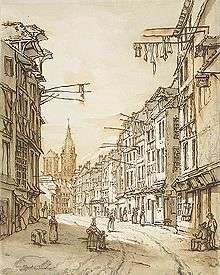 "Street in Lisieux" by Henry Edridge
"Street in Lisieux" by Henry Edridge Basilique de Sainte-Thérèse
Basilique de Sainte-Thérèse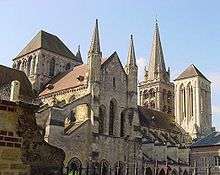 Lisieux Cathedral
Lisieux Cathedral
See also
References
- ↑ François Neveux, Bayeux et Lisieux, villes épiscopales de Normandie à la fin du Moyen Age (Éditions Lys, 1996)
- ↑ These figures, cited on the French wikipedia page for Lisieux, are drawn from the Internet site for the nearby town of Caen Caen and from France's National Meteorology site LaMeteo.org(both in French).
- ↑ Meteo France (in French)
- ↑ Meteo France and LaMeteo.org (both in French)
- ↑ Hôtel de ville : Lisieux. Lisieux : Mairie de Lisieux, 2007, d'après A.-J.L. Dingremont, Du corps municipal de Lisieux. Lisieux, J.J. Pigeon, 1849.
External links
| Wikimedia Commons has media related to Lisieux. |
- Lisieux website (French)
- Tourism website (French) (English) (German)
- Georges Vérez. sculptor of Lisieux War Memorial.
